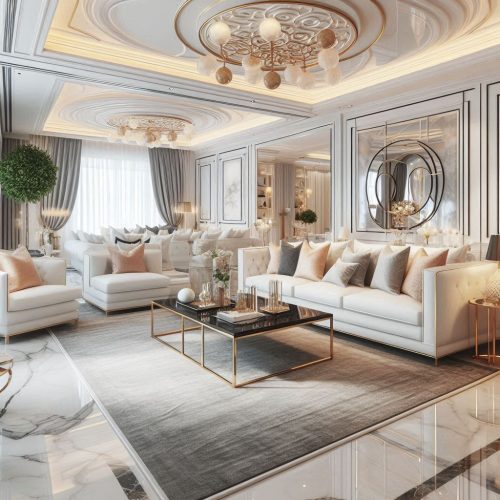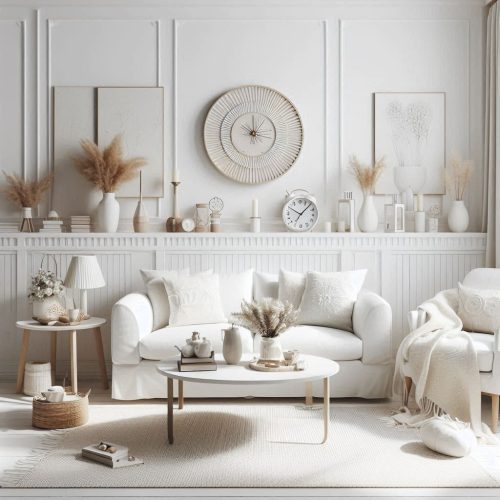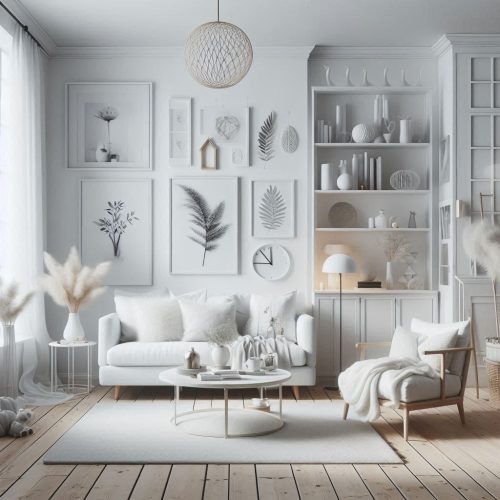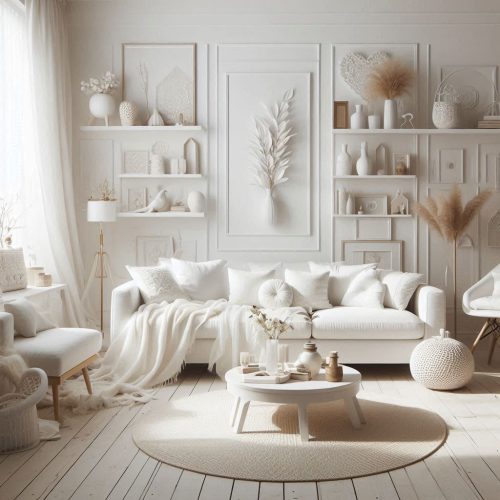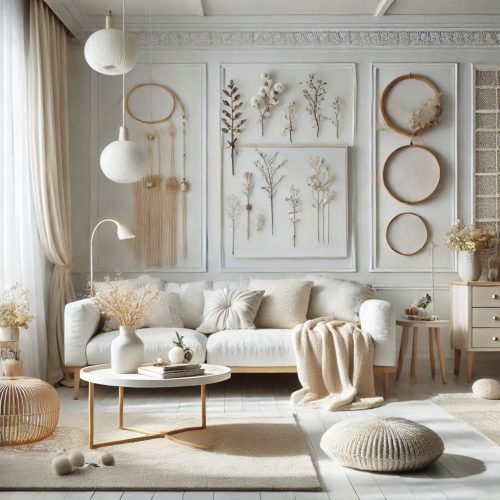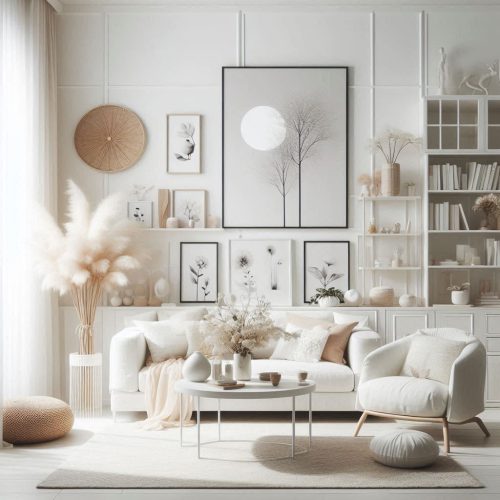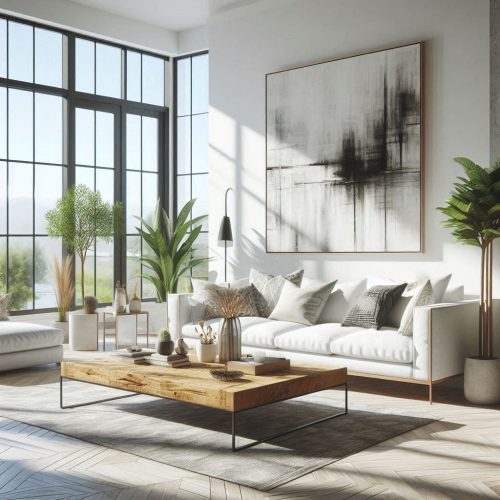The White Aesthetic in Living Room Design
A white aesthetic in the living room is a timeless choice that creates an atmosphere of simplicity, elegance, and tranquility. Whether you prefer a minimalist, contemporary, or classic look, using white as the dominant color can transform a space into a serene, open, and inviting area. Here’s a detailed exploration of how to create a stunning white aesthetic in your living room.
1. The Essence of White Aesthetic
The white aesthetic in interior design emphasizes a sense of light, airiness, and calm. It often evokes feelings of cleanliness and purity, allowing other elements of the space—such as furniture, decor, and natural light—to shine. The white palette can vary from stark, crisp whites to softer, warmer whites, depending on the mood and style you want to create.
White serves as a versatile backdrop that can be paired with virtually any color or texture. However, when you focus on a predominantly white aesthetic, the challenge lies in balancing the purity of white with depth, warmth, and texture to avoid a sterile or cold atmosphere.
2. Color Scheme and Walls
To achieve a true white aesthetic, start with the walls. Painting the walls in shades of white is a fundamental step in creating this look. You can opt for a bright, cool white for a modern, fresh feel or choose a warm white, like ivory or cream, to add a touch of coziness and sophistication. Here are some considerations for your walls:
- Crisp White: For a clean, modern look, choose a pure, cool white. This works well in spaces with abundant natural light.
- Soft Off-White: A subtle off-white, like eggshell or ivory, can create a warmer atmosphere while maintaining the purity of the white aesthetic.
- Textured Walls: For added visual interest, you can incorporate textured wall finishes like whitewashed wood, stucco, or wainscoting to bring depth and contrast.
If you prefer a more creative touch, consider a feature wall with a slightly different tone or subtle patterns to break up the monotony without deviating too far from the aesthetic.
3. Furniture Choices
Furniture plays a central role in a white aesthetic. While it’s tempting to choose all-white furniture, incorporating different materials and textures will help keep the space dynamic and inviting.
- Sofas & Chairs: Opt for white or off-white sofas with clean lines and minimalist designs. Consider using neutral tones for cushions and throws to add dimension. Materials such as linen, cotton, and leather are excellent choices for a chic and durable look.
- Coffee Tables: White marble or wood coffee tables with a simple design can act as a statement piece. The texture of marble or the natural grain of wood contrasts beautifully against the uniformity of white walls and furniture.
- Side Tables & Storage: Incorporate white side tables or shelving units to maintain cohesion in the room. Open shelves in white or light wood provide functional storage while keeping the space feeling open and organized.
To add character, you can include accent pieces in soft neutrals or metallic finishes like gold, silver, or matte black. These accents break up the monotony of white while maintaining a sleek and sophisticated aesthetic.
4. Flooring and Rugs
The flooring should complement the white aesthetic while providing some contrast and warmth. Some excellent flooring options include:
- Light Wood: Wooden floors in pale shades like oak or ash create a cozy yet airy environment, balancing the crispness of the white with natural warmth.
- Polished Concrete: For a contemporary industrial look, polished concrete flooring in a soft gray tone works well in minimalist spaces.
- White or Light-Colored Marble: Marble floors with subtle veining in gray or beige are luxurious and timeless, giving a sophisticated and upscale feel to your living room.
To soften the floor and add comfort, layer the space with white or neutral-colored rugs. Look for rugs with subtle textures or patterns, such as a light woven wool rug or a flatweave in a soft ivory tone. A large rug will also anchor the furniture and create a sense of cohesion.
5. Lighting and Windows
Lighting is critical in a white-themed living room, as it can enhance the brightness and highlight the beautiful details in the space. Maximizing natural light is essential, so ensure your windows are unobstructed. Consider these options:
- Sheer White Curtains: Light, airy curtains in white or pale cream allow natural light to filter through while maintaining privacy. The texture of the fabric adds a gentle softness to the space.
- Statement Lighting: Install pendant lights or chandeliers with white or frosted glass shades to maintain a cohesive look. For a touch of luxury, opt for gold or silver accents in the light fixtures.
- Table and Floor Lamps: Soft, warm lighting can be introduced with white lampshades. Use table lamps on side tables and a floor lamp near seating areas for layered lighting.
If possible, take advantage of natural light by placing furniture near windows to create a bright and welcoming atmosphere.
6. Decor and Accessories
When it comes to decor, simplicity is key in maintaining the purity of the white aesthetic. However, you can introduce subtle accents to add character and personality to the room:
- Mirrors: A large mirror with a white or metallic frame can reflect light and make the space feel larger.
- Art and Photography: Keep the art minimalistic—black-and-white photography, abstract prints, or soft pastel pieces work well with white decor.
- Vases and Sculptures: Ceramic or glass vases in white or soft neutral tones can hold greenery or fresh flowers. Sculptural elements, such as abstract sculptures, can add an artistic flair to the room.
- Throw Pillows and Blankets: Layering a variety of throw pillows in whites, creams, and soft pastels will add texture and warmth. Cashmere or knitted throws can make the room feel cozy while complementing the aesthetic.
While white should dominate, consider using metallic accents in gold, silver, or matte black for added elegance and a sense of contrast.
7. Plants and Greenery
Adding plants to a white living room is essential to break up the neutrality and introduce life into the space. Greenery provides a refreshing contrast to the white tones while promoting a sense of tranquility. Choose plants with large, lush leaves like snake plants, peace lilies, or fiddle leaf figs to bring nature indoors.
Use white or neutral planters to maintain the aesthetic. Ceramic pots, woven baskets, or even simple glass containers can house your plants while complementing the minimalist vibe.
8. Balancing the White with Warmth
While the white aesthetic is beautiful, it’s important to introduce some warmth and variety to avoid the space feeling too clinical or cold. Here are some ways to introduce warmth:
- Wood Accents: Incorporate wooden elements such as a coffee table, side tables, or bookshelves. Wood introduces natural warmth and texture.
- Textural Variety: Mix different textures, like velvet cushions, wool rugs, and cotton throw blankets, to create a balanced environment that feels cozy rather than stark.
- Accent Colors: Introduce soft, muted colors in your accessories, such as light pastel tones or deep earthy shades like taupe, beige, or blush pink, to maintain the serenity of the space while providing interest.
9. Minimalism and Clutter-Free Living
One of the hallmarks of the white aesthetic is minimalism. Keeping the room uncluttered is essential to maintaining the serene and spacious feeling that a white living room provides. To achieve this:
- Declutter Regularly: Ensure that there’s no excess clutter in the room. Utilize hidden storage spaces to keep things organized.
- Clean Lines and Simple Designs: Choose furniture and decor with simple, clean lines, avoiding overly ornate or heavy pieces.
- Functional Decor: Opt for decor that also serves a functional purpose, such as stylish baskets for storage, sleek shelving, or multi-purpose furniture.
Conclusion
The white aesthetic in a living room creates a serene, sophisticated, and timeless atmosphere. By thoughtfully incorporating furniture, decor, lighting, and natural elements, you can create a space that feels open, fresh, and harmonious. With careful attention to balance, texture, and warmth, a white aesthetic can serve as the perfect foundation for a relaxing, stylish, and inviting living room that is both visually appealing and functional.





